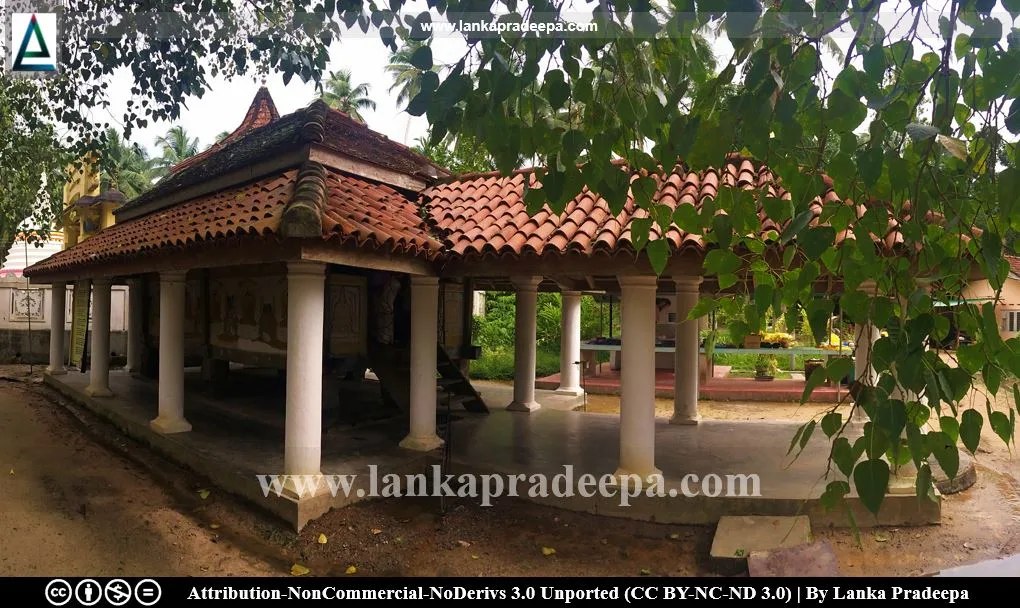
|
Metikotumulla Tempita Viharaya |
Metikotumulla Tempita Viharaya, also known as Sri Saddharma Thilakarama Viharaya (Sinhala: මැටිකොටුමුල්ල ටැම්පිට විහාරය, ශ්රී සද්ධර්ම තිලකාරාම විහාරය), is a Buddhist temple situated in Essella village in Gampaha District, Sri Lanka.
History
Metikotumulla
The history of the Metikotumulla area, according to folk, is connected with Sakalakala Wallabha (or Sakalakala Wallakabahu), a provincial king appointed during the Kotte Period. Several historical sources such as Rajavaliya and Alakeshwara Yuddhaya (The battle of Alakeshwara) reveal that King Sakalakala Wallabha, one of the sons of King Vira Parakramabahu VIII (1490-1509 A.D.) had ruled this region. According to locals, Sakalakala Wallabha planned to construct a new irrigation tank in the Essella and the clays used to construct the dam were extracted from the area where the present temple is situated. After that, the area became to known as Meti-ketu-mulla (clay-ploughed-corner) and it was later evolved to the present name Meti-kotu-mulla.
The Temple
One of the stone pillars used in the Tempita Viharaya building contains the date 1893 and therefore, locals believe that this temple has been established in that year. However, the date 2454 B.E. (1911 A.D.) is found drawn on the front wall of the verandah of the Tempita building.
Tempita Viharaya
Tempita Viharas (the temples on pillars) were a popular aspect of many Buddhist temples during the Kandyan Period. These structures were usually built on a wooden platform resting on bare stone pillars or stumps which are about 1-4 feet tall. The roof is generally made of timber and held by wooden stumps. The walls are usually made of wattle and daub and they form the main enclosed shrine room containing the Buddhist sculptures and murals belonging to the Kandyan style. Some Tempita Viharas have narrow verandas and ambulatories circulating the main enclosed space. The construction of these buildings started in the 17th century and lasted until the end of the 19th century (Wijayawardhana, 2010).
Metikotumulla Tempita Viharaya
The Tempita Viharaya is the main monument of this temple with archaeological value. It is a rectangular building constructed upon 9 granite pillars about 2 feet tall (Chandrasoma, 2013). The building is 14 feet 6 inches long and 10 feet 6 inches wide and an open-ambulatory has been built around it (Chandrasoma, 2013). The ambulatory is 4 feet 7.5 inches wide and its roof which has been tiled with Sinhala Ulu (semi-circular tiles) is borne by several circular pillars erected around the Tempita shrine (Chandrasoma, 2013). The roof of the Tempita shrine is sloping in four directions and has been balanced on supportive wooden pillars as well as the wattle wall of the building. The Maliga Ulu (flat clay tiles) have been used to tile the roof. Also, a small open hall (a Hewisi Mandapaya) has been attached to the ambulatory in front of the shrine.
The Tempita shrine can be accessed through a wooden flight of steps leading to the small verandah in front of the entrance door. The entrance door has been placed in the western direction and is guarded by four figures of deities including God Visnu and God Kataragama. A seated Buddha statue accompanied by two images of Sariputta (left) and Moggallana (right), the chief disciples of Gautama Buddha is found inside the shrine.
The inner walls of the shrine have been decorated with paintings depicting Buddhist themes. "The Sath-sathiya (the first seven weeks after attaining Buddhahood)", "the offering of food to the Buddha by Tapassu Balluka (or Trapusa & Bahalika)", "Sahampathi's invitation to Buddha to deliver the first sermon Dhammacakkappavattana Sutta", "the offering of Deheti to the Buddha by God Sakra" are found among them. The outer walls of the shrine are adorned with paintings depicting "the Suvisi-vivaranaya (Buddha to be receiving the blessing from 24 previous Buddhas)". Locals say that these outer wall paintings were drawn by a painter named Arunolis, a student of the famous Kelani Vihara painter Solias Mendis.
A Protected Site
The ancient Tampita Viharaya on the premises of the Metikotamulla Saddharmathilakarama Vihara in the Divisional Secretary’s Division of Minuwangoda is an archaeological protected monument, declared by a government gazette notification published on 22 November 2002.


Related Posts
Read Also
References
Books, Government Gazette Notifications
1) Chandrasoma, S., 2013. Gampaha Distrikkaye Tempita Vihara (In Sinhala). Department of Archaeology (Sri Lanka). Colombo. ISBN: 978-955-9159-85-8. pp.43-49.
2) Wijayawardhana, K., 2010. Sri Lankawe Tampita Vihara (In Sinhala). Dayawansa Jayakody & Company. Colombo. ISBN: 978-955-551-752-2. p. 12.
3) The Gazette of the Democratic Socialist Republic of Sri Lanka. No: 1264. 22 November 2002.



